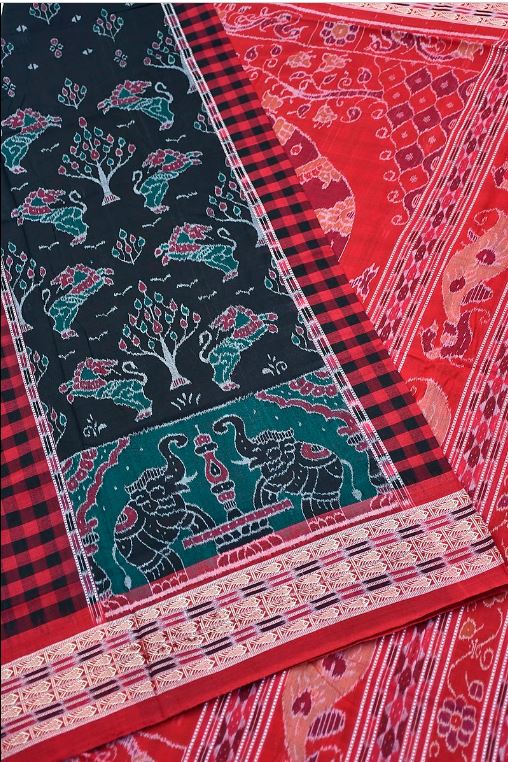Sambalpuri Saree is an authentic and traditional hand woven ikat from Odisha, a state in eastern India. The Tie-dye art reflected in the saree is a technique where the threads are first tie-dyed and later woven into fabric. Mainly sambalpuri saree are produced in Bargarh, Sonepur, Sambalpur, Balangir district and Boudh district of Odisha. These sarees are known for its extra-ordinarily woven pallus and borders in contrasting colors and meaningful inspired from temples of Odisha. The sarees are 100% hand-woven.
It is believed that the art of sambalpuri ikat migrated to Western Odisha with the Bhulia community who are believed to have fled Northern India after the fall of the Chouhan Empire at the hands of the Mughals in the year 1192 AD. Since then and up to the year 1925, this art flourished in Western Odisha with just limited number of designs and consisted mostly of sarees used by the womenfolk of Odisha that came in few standard vegetable colors. These sarees are known as ‘Bhulia-Kapta’. In 1980s the sambalpuri sarees gain its popularization because of the then Prime Minister smt. Indira Gandhi.
Sambalpuri Sarees reflect an original style of craft named ‘Baandha’. Traditionally, craftsmen created Baandhas with images of flower and animals or with geometrical shapes. Latest designs depicts portraits, landscape and flower pots. The yarns of sambalpuri sarees are tied according to the desired patterns to prevent absorption of dyes, and then dyed. These sarees are said to be unique as the designs are reflected almost identically on both the sides of saree. This versatile technique enables a craftsman to weave colorful designs, patterns and image into a saree capable of inspiring a thought or conveying a message.
The making of sambalpuri saree requires a lot of patience as well as fine skills. The sarees are created with three shuttle weaving technique and extra heald shaft design on primitive pit looms. The procedure is labor intensive and hence expensive. The price ranges from 3000 to 5,00,000 INR. There are showrooms for sambalpuri sarees but a small village named Balijori, 12km from the district headquarters of Bargarhis quite famous.
In Balijori, the world famous sambalpuri saree is marketed under the open sky. Every Friday thousand of weavers from many western Odisha districts gather on a roadside to sell their weaves just like vegetables in local mandis. Realizing that the market is growing, the state government has decided to construct ‘boonakar bazaar’ with concrete sheds, provision of drinking water, toilets and other basic amenities right in front of the place where the weavers gather.




Comments are closed.